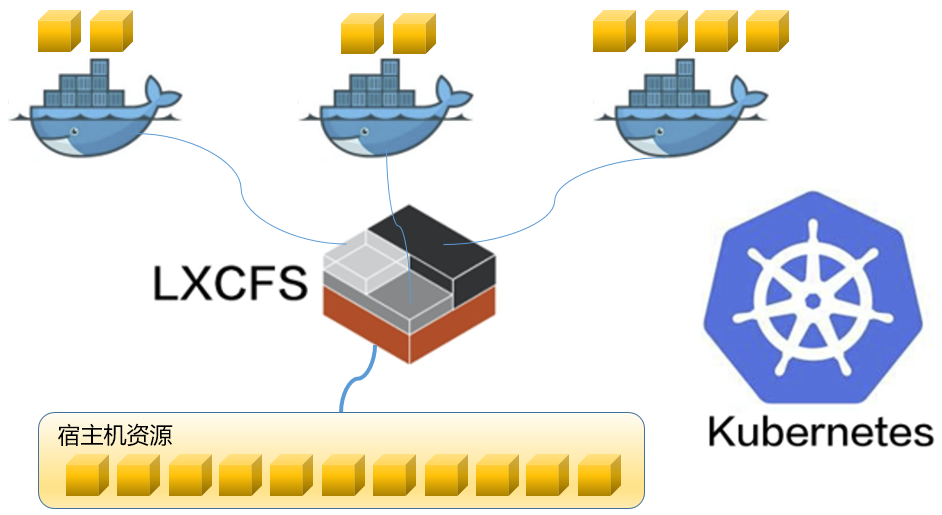lxcfs的Kubernetes实践
lxcfs 的 Kubernetes 实践

启用 fuse 模块
先确保节点都开启 fuse 内核模块,并写入文件
rbac
准备 rbac
---
kind: ServiceAccount
apiVersion: v1
metadata:
name: lxcfs-manager-sa
namespace: lxcfs
labels:
app.kubernetes.io/name: lxcfs-manager
imagePullSecrets:
- name: lxcfs-image-pull-secrets
---
apiVersion: rbac.authorization.k8s.io/v1
kind: ClusterRole
metadata:
name: 'lxcfs-manager-cr'
labels:
app.kubernetes.io/name: lxcfs-manager
rules:
- apiGroups:
- ""
resources:
- configmaps
- events
verbs:
- '*'
- apiGroups:
- coordination.k8s.io
resources:
- leases
verbs:
- '*'
- apiGroups:
- ""
resources:
- pods
verbs:
- '*'
---
apiVersion: rbac.authorization.k8s.io/v1
kind: ClusterRoleBinding
metadata:
name: 'lxcfs-manager-crb'
labels:
app.kubernetes.io/name: lxcfs-manager
roleRef:
apiGroup: rbac.authorization.k8s.io
kind: ClusterRole
name: 'lxcfs-manager-cr'
subjects:
- kind: ServiceAccount
name: lxcfs-manager-sa
namespace: "lxcfs"
使用 DaemonSet 启动 lxcfs
要在集群节点上安装并启动 lxcfs,将用 Kubernetes 的方式,用利用容器和 DaemonSet 方式来运行 lxcfs FUSE 文件系统
由于 lxcfs FUSE 需要共享系统的 PID 名空间以及需要特权模式,所以配置了相应的容器启动参数
apiVersion: apps/v1
kind: DaemonSet
metadata:
name: 'lxcfs-controller-manager-daemonset'
namespace: "lxcfs"
labels:
app.kubernetes.io/name: lxcfs-manager
app.kubernetes.io/compose: lxcfs
spec:
selector:
matchLabels:
app.kubernetes.io/name: lxcfs-manager
app.kubernetes.io/compose: lxcfs
template:
metadata:
annotations:
{}
labels:
app.kubernetes.io/name: lxcfs-manager
app.kubernetes.io/compose: lxcfs
spec:
serviceAccountName: lxcfs-manager-sa
imagePullSecrets:
- name: lxcfs-image-pull-secrets
containers:
- name: agent
args:
- -l
- --enable-cfs
- --enable-pidfd
- /var/lib/lxcfs
- --enable-loadavg
- -o
- allow_other,nonempty
image: ghcr.io/cndoit18/lxcfs-agent:v0.1.4
imagePullPolicy: "IfNotPresent"
resources:
limits:
cpu: 500m
memory: 300Mi
requests:
cpu: 300m
memory: 200M
securityContext:
privileged: true
volumeMounts:
- mountPath: /var/lib/lxcfs
mountPropagation: Bidirectional
name: lxcfs
- mountPath: /sys/fs/cgroup
name: cgroup
hostPID: true
volumes:
- hostPath:
path: /var/lib/lxcfs
type: DirectoryOrCreate
name: lxcfs
- hostPath:
path: /sys/fs/cgroup
name: cgroup
建议增加优先级,保证服务始终运行
webhook
webhook 部署
---
apiVersion: v1
kind: Service
metadata:
name: 'lxcfs-webhook-service'
namespace: "lxcfs"
labels:
app.kubernetes.io/name: lxcfs-manager
app.kubernetes.io/compose: manager
spec:
type: ClusterIP
ports:
- port: 443
targetPort: webhook-server
protocol: TCP
name: https
selector:
app.kubernetes.io/name: lxcfs-manager
app.kubernetes.io/compose: manager
---
apiVersion: cert-manager.io/v1
kind: Issuer
metadata:
name: 'lxcfs-selfsigned-issuer'
namespace: "lxcfs"
labels:
app.kubernetes.io/name: lxcfs-manager
spec:
selfSigned: {}
---
apiVersion: cert-manager.io/v1
kind: Certificate
metadata:
name: 'lxcfs-serving-cert'
namespace: "lxcfs"
labels:
app.kubernetes.io/name: lxcfs-manager
spec:
dnsNames:
- 'lxcfs-webhook-service.lxcfs.svc'
- 'lxcfs-webhook-service.lxcfs.svc.cluster.local'
issuerRef:
kind: Issuer
name: 'lxcfs-selfsigned-issuer'
secretName: 'lxcfs-certificate'
---
apiVersion: apps/v1
kind: Deployment
metadata:
name: 'lxcfs-controller-manager'
namespace: "lxcfs"
labels:
app.kubernetes.io/name: lxcfs-manager
app.kubernetes.io/compose: manager
spec:
selector:
matchLabels:
app.kubernetes.io/name: lxcfs-manager
app.kubernetes.io/compose: manager
template:
metadata:
annotations:
{}
labels:
app.kubernetes.io/name: lxcfs-manager
app.kubernetes.io/compose: manager
spec:
serviceAccountName: lxcfs-manager-sa
imagePullSecrets:
- name: lxcfs-image-pull-secrets
containers:
- name: manager
args:
- --lxcfs-path=/var/lib/lxcfs
- --v=4
- --leader-election=true
- --leader-election-namespace=aipaas-system
- --leader-election-id=lxcfs-on-kubernetes-leader-election
image: ghcr.io/cndoit18/lxcfs-manager:v0.1.4
imagePullPolicy: "IfNotPresent"
ports:
- containerPort: 9443
name: webhook-server
protocol: TCP
resources:
limits:
cpu: 500m
memory: 300Mi
requests:
cpu: 300m
memory: 200Mi
volumeMounts:
- mountPath: /tmp/k8s-webhook-server/serving-certs
name: cert
readOnly: true
terminationGracePeriodSeconds: 10
volumes:
- name: cert
secret:
defaultMode: 420
secretName: 'lxcfs-certificate'
创建 webhook,可以用于对资源创建进行拦截和注入处理,可以借助它优雅地完成对 lxcfs 文件的自动化挂载
apiVersion: admissionregistration.k8s.io/v1
kind: MutatingWebhookConfiguration
metadata:
annotations:
cert-manager.io/inject-ca-from: 'lxcfs/lxcfs-serving-cert'
name: 'lxcfs-mutating-webhook-configuration'
webhooks:
- name: club.cndoit18.lxcfs
namespaceSelector:
matchLabels:
mount-lxcfs: enabled
admissionReviewVersions:
- v1
clientConfig:
service:
name: 'lxcfs-webhook-service'
namespace: "lxcfs"
path: /mount-lxcfs
failurePolicy: Ignore
rules:
- apiGroups:
- ""
apiVersions:
- v1
operations:
- CREATE
resources:
- pods
sideEffects: NoneOnDryRun
测试
给指定的命名空间加上 label
创建一个测试 pod
apiVersion: v1
kind: Pod
metadata:
name: debug-tools
namespace: default
spec:
volumes:
- hostPath:
path: /mnt/beegfs/quant-data
type: DirectoryOrCreate
name: beegfs-test
containers:
- name: demo
image: docker.io/rockylinux/rockylinux:9.1.20221123
resources:
requests:
cpu: "1"
memory: "2048Mi"
limits:
cpu: "1"
memory: "2048Mi"
command: ["sh"]
args: ["-c", "sleep 1000d"]
volumeMounts:
- mountPath: /data
name: beegfs-test
安装工具
可以看到 free 命令返回的 total memory 就是我们设置的容器资源容量
[root@debug-tools /]# free -m
total used free shared buff/cache available
Mem: 2048 4 1980 0 62 2043
Swap: 0 0 0
可以检查上述 Pod 的配置,果然相关的 procfs 文件都已经挂载正确
> kubectl describe pod -n default debug-tools
...
Volumes:
kube-api-access-qr5vn:
Type: Projected (a volume that contains injected data from multiple sources)
TokenExpirationSeconds: 3607
ConfigMapName: kube-root-ca.crt
ConfigMapOptional: <nil>
DownwardAPI: true
lxcfs-proc-cpuinfo:
Type: HostPath (bare host directory volume)
Path: /var/lib/lxcfs/proc/cpuinfo
HostPathType:
lxcfs-proc-diskstats:
Type: HostPath (bare host directory volume)
Path: /var/lib/lxcfs/proc/diskstats
HostPathType:
lxcfs-proc-loadavg:
Type: HostPath (bare host directory volume)
Path: /var/lib/lxcfs/proc/loadavg
HostPathType:
lxcfs-proc-meminfo:
Type: HostPath (bare host directory volume)
Path: /var/lib/lxcfs/proc/meminfo
HostPathType:
lxcfs-proc-stat:
Type: HostPath (bare host directory volume)
Path: /var/lib/lxcfs/proc/stat
HostPathType:
lxcfs-proc-swaps:
Type: HostPath (bare host directory volume)
Path: /var/lib/lxcfs/proc/swaps
HostPathType:
lxcfs-proc-uptime:
Type: HostPath (bare host directory volume)
Path: /var/lib/lxcfs/proc/uptime
HostPathType:
lxcfs-sys-devices-system-cpu:
Type: HostPath (bare host directory volume)
Path: /var/lib/lxcfs/sys/devices/system/cpu
HostPathType:
lxcfs-sys-devices-system-cpu-online:
Type: HostPath (bare host directory volume)
Path: /var/lib/lxcfs/sys/devices/system/cpu/online
HostPathType:
自动 remount 问题
故障恢复,如何自动 remount? 如果 lxcfs 进程重启了,那么容器里的 /proc/cpuinfo 等等都会报transport connected failed 这个是因为 /var/lib/lxcfs 会删除再重建,inode 变了
[root@debug-tools /]# free -g
Error: /proc must be mounted
To mount /proc at boot you need an /etc/fstab line like:
proc /proc proc defaults
In the meantime, run "mount proc /proc -t proc"
共享 mount 事件,重新给容器挂载
-
https://github.com/alibaba/pouch/issues/140
-
https://github.com/lxc/lxcfs/issues/193
https://github.com/xigang/lxcfs-admission-webhook/blob/dev/script/container_remount_lxcfs.sh
#! /bin/bash
PATH=$PATH:/bin
LXCFS="/var/lib/lxc/lxcfs"
LXCFS_ROOT_PATH="/var/lib/lxc"
containers=$(docker ps | grep -v pause | grep -v calico | awk '{print $1}' | grep -v CONTAINE)
#-v /var/lib/lxc/lxcfs/proc/cpuinfo:/proc/cpuinfo:rw
#-v /var/lib/lxc/lxcfs/proc/diskstats:/proc/diskstats:rw
#-v /var/lib/lxc/lxcfs/proc/meminfo:/proc/meminfo:rw
#-v /var/lib/lxc/lxcfs/proc/stat:/proc/stat:rw
#-v /var/lib/lxc/lxcfs/proc/swaps:/proc/swaps:rw
#-v /var/lib/lxc/lxcfs/proc/uptime:/proc/uptime:rw
#-v /var/lib/lxc/lxcfs/proc/loadavg:/proc/loadavg:rw
#-v /var/lib/lxc/lxcfs/sys/devices/system/cpu/online:/sys/devices/system/cpu/online:rw
for container in $containers;do
mountpoint=$(docker inspect --format '{{ range .Mounts }}{{ if eq .Destination "/var/lib/lxc" }}{{ .Source }}{{ end }}{{ end }}' $container)
if [ "$mountpoint" = "$LXCFS_ROOT_PATH" ];then
echo "remount $container"
PID=$(docker inspect --format '{{.State.Pid}}' $container)
# mount /proc
for file in meminfo cpuinfo loadavg stat diskstats swaps uptime;do
echo nsenter --target $PID --mount -- mount -B "$LXCFS/proc/$file" "/proc/$file"
nsenter --target $PID --mount -- mount -B "$LXCFS/proc/$file" "/proc/$file"
done
# mount /sys
for file in online;do
echo nsenter --target $PID --mount -- mount -B "$LXCFS/sys/devices/system/cpu/$file" "/sys/devices/system/cpu/$file"
nsenter --target $PID --mount -- mount -B "$LXCFS/sys/devices/system/cpu/$file" "/sys/devices/system/cpu/$file"
done
fi
done